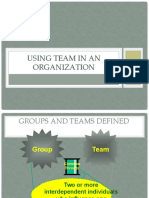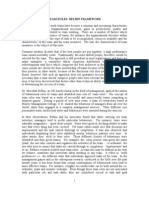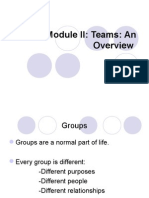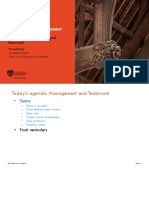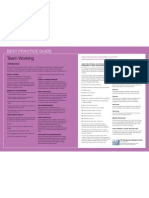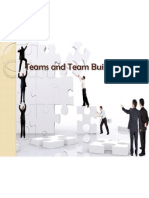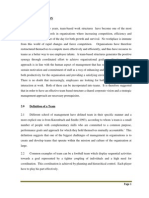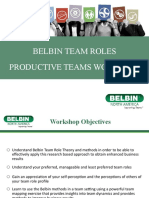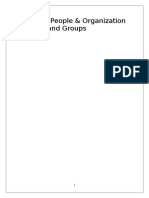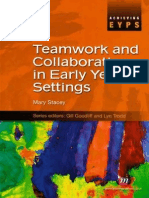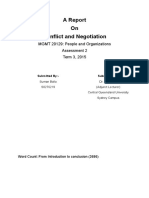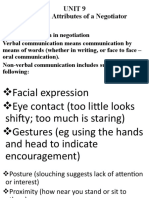Melbourne
School of Engineering (MSE)
Department of Mechanical Engineering (DME)
MCEN90013
Design for Integration
Design Project 5 Gearbox
Engineering Team Development
Dr Peter Goldsmith
p.goldsmith@unimelb.edu.au
�Tuckmans Five-Stage Theory
of Group Development
Forming
Individual
Issues
Group
Issues
Storming
Norming
Performing
How do I fit
in?
Whats my
role here?
What do the How can I best
others expect perform my
me to do?
role?
Why are we
here?
Why are we
fighting over
whos in
charge and who
does what?
Can we agree
on roles and Can we do the
work as a
job properly?
team?
��Team
A small group of people with complementary
skills, who work together to accomplish shared
goals while holding themselves mutually
accountable for performance results.
Teamwork
The process of people working together to
accomplish these goals.
Team size aects how members work together,
handle disagreements and reach agreements.
Ge+ng to know each other
Weekly mee4ngs?
Swap names and contacts
Set up Dropbox
Team Focus/Goals
�- Team Leadership?
- Bring ideas & topics
- Topic Discussion
- Decision Making process
- Rules of engagement
� When people are unhappy with something
they will want to be heard. Team members
must listen and a resoluIon to the issue(s)
achieved.
If this does NOT occur then the team will NOT
progress through norming and to the working
stage.
�- Clear idea of team goals
- Belbin roles clearly understood
- Team behaviours
- Trust levels within the team
- Homogeneous / Heterogeneous
�Norms
Behaviours, rules or standards expected to be
followed by team members.
Guidelines to build posi4ve norms:
Act as a posiIve role model
Reinforce the desired behaviours
Control results with reviews and feedback
Regularly discuss progress
Use team decision-making methods.
� Synergy is the creaIon of a whole that is greater than the
sum of its parts; in teams, it is seen when members
individual talents and eorts are used to achieve/create.
More resources for problem-solving.
Improved crea4vity and innova4on.
Improved quality of decision-making.
Greater commitments to tasks.
Higher moIvaIon through collec4ve ac4on.
BeUer control and work discipline.
�Work in progress
EecIve Teams: Clearly dened tasks make it easier
for team members to focus their
work eorts.
Dr Burvill has achieved this by structuring the
gearbox guidelines.
� Achievements - what? how?
High Team Trust = Innova4on what? how?
Outcome focus
�Introducing Someone New
Group Conict
�� De-brief the project
Celebrate successes
A Ime to say goodbye
No airport scene
�Team Building Roles - BELBIN
Theory
Certain types of individual do not perform well
when working together in the same team.
Argued that people have dierent psychological
characterisIcs which cause them to adopt
parIcular roles at work, & that an appropriate
combinaIon of persons assuming various roles is
essenIal for the creaIon of a well-balance team.
9 team roles
Specic roles according to psychological make up
of team member
�BELBIN Team-Role Type
Contributions
Allowable Weaknesses
PLANT
Creative, imaginative, unorthodox.
Solves difficult problems.
Ignores incidentals. Too pre-occupied to
communicate effectively.
CO-ORDINATOR
Mature, confident, a good chairperson.
Clarifies goals, promotes decisionmaking, delegates well.
Can often be seen as manipulative. Off
loads personal work.
MONITOR-EVALUATOR
Sober, strategic and discerning.
Sees all options. Judges accurately.
Lacks drive and ability to inspire others.
IMPLEMENTOR
Disciplined, reliable, conservative
and efficient. Turns ideas into
practical actions.
Somewhat inflexible. Slow to respond to
new possibilities.
COMPLETER-FINISHER
Painstaking, conscientious, anxious.
Searches out errors and omissions.
Delivers on time.
Inclined to worry unduly. Reluctant to
delegate.
RESOURCE
INVESTIGATOR
Extrovert, enthusiastic,
communicative. Explores
opportunities. Develops contacts.
Over - optimistic. Loses interest once
initial enthusiasm has passed.
SHAPER
TEAMWORKER
SPECIALIST
Challenging, dynamic, thrives on
pressure. The drive and courage to
overcome obstacles.
Co-operative, mild, perceptive and
diplomatic. Listens, builds, averts
friction.
Single-minded, self-starting,
dedicated. Provides knowledge and
skills in rare supply.
Prone to provocation. Offends people's
feelings.
Indecisive in crunch situations.
Contributes only on a narrow front.
Dwells on technicalities.
�Responsibility Matrix for a Market
Research Type Project
�Reec4on
How do the dierent Belbin Team Roles best
contribute to the dierent stages in a project
�MCEN90013 Mechanical Design
End of Lecture

